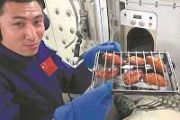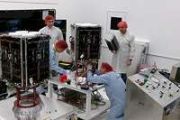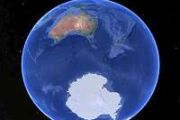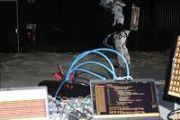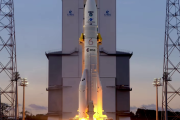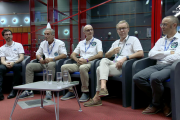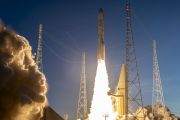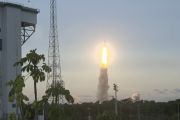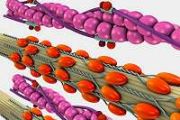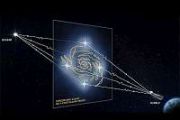
Copernical Team
Maxar awarded contract to build SXM-10 satellite for SiriusXM
 Maxar Technologies has received an order to build another geostationary communications satellite for longtime customer SiriusXM, following the SXM-9 satellite order that was announced earlier this month.
SXM-10, a high-powered digital audio radio satellite, will be built on Maxar's proven 1300-class platform at the company's manufacturing facility in Palo Alto, California.
Maxar has
Maxar Technologies has received an order to build another geostationary communications satellite for longtime customer SiriusXM, following the SXM-9 satellite order that was announced earlier this month.
SXM-10, a high-powered digital audio radio satellite, will be built on Maxar's proven 1300-class platform at the company's manufacturing facility in Palo Alto, California.
Maxar has Spacecom attains initial operational capability, commander says
 The U.S. Space Command has reached initial operational capability and is on the path to meeting full operational capability in the near future, its commander said.
Army Gen. James H. Dickinson speaking at this week's U.S. Space Foundation's 36th Space Symposium in Colorado Springs, Colorado, said "We were absolutely ready since day one," he said, referring to the date it was established, A
The U.S. Space Command has reached initial operational capability and is on the path to meeting full operational capability in the near future, its commander said.
Army Gen. James H. Dickinson speaking at this week's U.S. Space Foundation's 36th Space Symposium in Colorado Springs, Colorado, said "We were absolutely ready since day one," he said, referring to the date it was established, A OneWeb announces LEO flat-panel device for terrestrial broadband service
 OneWeb has unveiled its newest and smallest user terminal to offer high-speed Internet connectivity to businesses, governments and communities across the globe and in remote locations.
Developed in partnership with Intellian Technologies, Inc. and Collins Aerospace, the Compact-Electronically Steered Antenna OW1 user terminal, will play a key role in realising OneWeb's vision of bringing h
OneWeb has unveiled its newest and smallest user terminal to offer high-speed Internet connectivity to businesses, governments and communities across the globe and in remote locations.
Developed in partnership with Intellian Technologies, Inc. and Collins Aerospace, the Compact-Electronically Steered Antenna OW1 user terminal, will play a key role in realising OneWeb's vision of bringing h US Space Force OPIR Program completes Block 0 GEO Space Vehicle CDR
 The United States Space Force's Space Systems Command, Next Generation Overhead Persistent Infrared program, successfully passed a major milestone, completing its Block 0 Geosynchronous Earth Orbit Space Vehicle Critical Design Review on Aug. 20, 2021.
This CDR milestone, the culmination of 34 subsystem and payload reviews, locks the space vehicle technical baseline, a key step in validati
The United States Space Force's Space Systems Command, Next Generation Overhead Persistent Infrared program, successfully passed a major milestone, completing its Block 0 Geosynchronous Earth Orbit Space Vehicle Critical Design Review on Aug. 20, 2021.
This CDR milestone, the culmination of 34 subsystem and payload reviews, locks the space vehicle technical baseline, a key step in validati Automatic Observation Management System, New Tool to Coordinate Telescope Network
 The incorporation of distinct telescopes into larger coordinated networks can enhance the discovery and follow-up capacity. However, challenges still remain in scaling, deploying, organizing and scheduling such networks.
A Chinese-French joint team from Space Variable Object Monitor (SVOM) mission developed an Automatic Observation Management (AOM) system to incorporate individual faciliti
The incorporation of distinct telescopes into larger coordinated networks can enhance the discovery and follow-up capacity. However, challenges still remain in scaling, deploying, organizing and scheduling such networks.
A Chinese-French joint team from Space Variable Object Monitor (SVOM) mission developed an Automatic Observation Management (AOM) system to incorporate individual faciliti This exotic particle had an out-of-body experience; these scientists took a picture of it
 Scientists have taken the clearest picture yet of electronic particles that make up a mysterious magnetic state called a quantum spin liquid (QSL).
The achievement could facilitate the development of superfast quantum computers and energy-efficient superconductors.
The scientists are the first to capture an image of how electrons in a QSL decompose into spin-like particles called spi
Scientists have taken the clearest picture yet of electronic particles that make up a mysterious magnetic state called a quantum spin liquid (QSL).
The achievement could facilitate the development of superfast quantum computers and energy-efficient superconductors.
The scientists are the first to capture an image of how electrons in a QSL decompose into spin-like particles called spi US Company to Work with Skybridge West Africa on $5 Billion Smart Cities Projects in Ghana
 TPT Global Tech, Inc. has entered into a strategic technology agreement with Skybridge West Africa (SWA) to participate in the development of 20 SMART Villages emulating that of Duval County Florida in the Country of Ghana.
SWA has been awarded a $5B community development approval from the Ghanaian Ministry of Works and Housing to develop and build over 100,000 newly constructed homes util
TPT Global Tech, Inc. has entered into a strategic technology agreement with Skybridge West Africa (SWA) to participate in the development of 20 SMART Villages emulating that of Duval County Florida in the Country of Ghana.
SWA has been awarded a $5B community development approval from the Ghanaian Ministry of Works and Housing to develop and build over 100,000 newly constructed homes util China to build satellite constellation for natural disaster observation
 China has initiated a project of building a constellation of 36 low-orbit satellites to gather information for forecasting natural disasters and monitoring urban emergencies.
The project undertaken by the Tianjin Satcom Geohe Technologies Co., Ltd. was inaugurated on Tuesday in China's spacecraft launch center of Wenchang, in South China's Hainan province.
Guo Jianqiang, president of
China has initiated a project of building a constellation of 36 low-orbit satellites to gather information for forecasting natural disasters and monitoring urban emergencies.
The project undertaken by the Tianjin Satcom Geohe Technologies Co., Ltd. was inaugurated on Tuesday in China's spacecraft launch center of Wenchang, in South China's Hainan province.
Guo Jianqiang, president of Mars helicopter sees potential rover road ahead
 Ask any space explorer, and they'll have a favorite photograph or two from their mission. For Ken Farley, the project scientist for NASA's Perseverance rover, one of his current favorites is a color image of "South Seitah," an area the mission's science team had considered potentially worthy of a rover visit. The agency's Ingenuity Mars Helicopter took the image during its 12th and most recent f
Ask any space explorer, and they'll have a favorite photograph or two from their mission. For Ken Farley, the project scientist for NASA's Perseverance rover, one of his current favorites is a color image of "South Seitah," an area the mission's science team had considered potentially worthy of a rover visit. The agency's Ingenuity Mars Helicopter took the image during its 12th and most recent f Film and cultures fly on SpaceX CR23 cargo resupply mission
 Samples of the Biofilms experiment are headed to the International Space Station on the SpaceX CR23 cargo resupply mission this weekend to help maintain astronaut and material safety in space.
A common piece of advice of the past 18 months has been to make sure you wash your hands thoroughly. This is because microorganisms are easily spread across common surfaces like door handles and ligh
Samples of the Biofilms experiment are headed to the International Space Station on the SpaceX CR23 cargo resupply mission this weekend to help maintain astronaut and material safety in space.
A common piece of advice of the past 18 months has been to make sure you wash your hands thoroughly. This is because microorganisms are easily spread across common surfaces like door handles and ligh 

